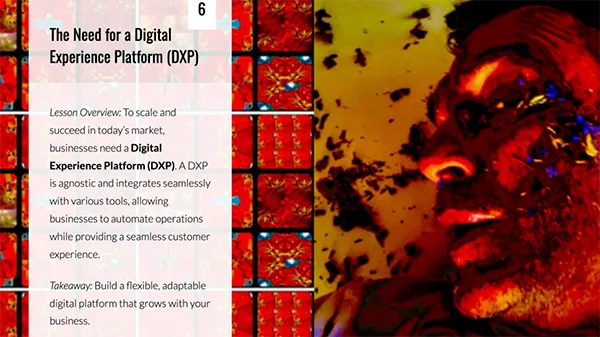
DXPs Are the New Fiberglass Hull. (Wait, What?)
DXPs Are the New Fiberglass Hull. (Wait, What?)
I’m from New England, and just down the road from me is the Wooden Shipbuilding Museum. If you’ve ever visited, you know the history and craftsmanship that went into building those iconic wooden vessels. But, indulge me for a second—DXPs are the new fiberglass hulls of business, and I’m ready to prove it.
Just as fiberglass transformed the shipbuilding industry—making ships lighter, faster, and more cost-effective—DXPs are revolutionizing how businesses operate by consolidating multiple systems into one seamless platform. It’s about more than just efficiency; it’s about creating a future-proof solution that scales as fast as your business needs it to.
So, buckle up, because we’re about to sail through the similarities and see how the rise of DXPs mirrors the shift from wooden boats to fiberglass hulls. Prove me wrong—let's dive in.
Y’all down with DXP? Yeah, you know me! Or maybe you’re thinking DMX “Y’all gonna make me lose my mind"—oh wait, I did that!” See previous posts.
LET'S DIG IN.
Let’s throw it back for a quick history lesson. Over 70 years ago, the fiberglass hull revolutionized the shipbuilding industry. Before that, ships were crafted from wood, a labor-intensive, intricate process. But then came fiberglass—lighter, more durable, and way easier to produce. It consolidated multiple materials and processes into one, making shipbuilding more efficient, cost-effective, and scalable. But like any major shift, it also ended jobs in traditional crafts while opening up new opportunities in the fiberglass industry.
Fast forward to today: Digital Experience Platforms (DXPs) are doing for business what fiberglass did for shipbuilding. Just like how fiberglass combined various materials into one more efficient solution, DXPs integrate multiple business functions—content management, customer data, analytics, marketing automation, and more—into a single, unified platform. It’s not just about improving customer experiences; it’s about consolidating and streamlining operations to reduce costs, automate tasks, and create new roles.
Now, let’s talk about how DXPs are creating massive shifts in industries. Retail, healthcare, finance, and education are just some sectors leveraging DXPs to deliver seamless, omnichannel experiences. These platforms help businesses scale faster, adapt to changing market conditions, and stay agile—just like how fiberglass allowed shipbuilders to scale production and adapt to the evolving needs of the industry.
How DXPs Are Changing the Workforce
Here’s the thing: As DXPs streamline business operations, they also consolidate roles. Just like the fiberglass hull replaced the need for specialized wooden shipbuilders, DXPs reduce the need for multiple staff members managing different systems. But here’s the twist—they also create new, hybrid roles that combine technical skills with customer experience, data analytics, and strategy.
Marketing automation experts, data analysts, and content managers are merging their skills with IT expertise.
Customer service teams are using AI and automation tools to improve efficiency.
IT professionals are collaborating with business leaders to integrate DXPs and align them with broader business goals.
Cost Reduction and Efficiency
Just like fiberglass hulls made shipbuilding more cost-effective, DXPs consolidate platforms and reduce staffing needs. By automating manual tasks, integrating multiple tools into one system, and providing centralized data, businesses can cut overhead costs, streamline workflows, and improve overall efficiency. For example, Mesa Collections reduced DXP infrastructure costs by 91% through a composable DXP architecture, showing just how much businesses can save when they consolidate their tools and processes.
The Future: Every Business is a DXP Whether You Know It or Not
In 2025, businesses will be operating with DXPs whether they recognize it or not. The need for integrated digital experiences is no longer optional; it’s essential for survival in today’s market. As with fiberglass hulls in shipbuilding, DXPs will be the new standard—creating streamlined, scalable, and cost-effective solutions that businesses can't afford to ignore. If you haven’t yet adopted a DXP, you’ll be playing catch-up in a world that’s already moved forward.
The Similarities Between DXP Consolidation and the Fiberglass Hull Revolution
Both the shift to fiberglass hulls in shipbuilding and the adoption of DXPs represent major consolidations that drastically changed the efficiency, scalability, and workforce landscape in their respective industries.
Job Creation and Loss: Just as fiberglass hulls replaced jobs in traditional wood-based shipbuilding, DXPs reduce the need for specialized staff managing multiple systems, but they also create new roles in technology, customer experience, and data management.
Speed of Delivery and Manufacturing: The introduction of fiberglass hulls sped up shipbuilding by reducing production time and costs. Similarly, DXPs automate and integrate processes, speeding up operations and making businesses more agile.
Cost Reduction: Both innovations streamlined production, reduced costs, and allowed for faster scalability. Fiberglass made ships cheaper to build, and DXPs make business operations more cost-effective and scalable.
So, when we ask about manufacturing jobs, will we be making fiberglass hulls or still building wooden boats? The answer is clear: DXPs are the fiberglass hulls of the digital age, creating a faster, more efficient, and scalable future for businesses. The question is—how quickly will you adopt?
#DXP #DigitalExperience #BusinessTransformation #TechInnovation #BusinessEfficiency #FiberglassHull #DigitalTransformation #CostReduction #BusinessGrowth #WorkforceEvolution #TechIntegration #BusinessInnovation
